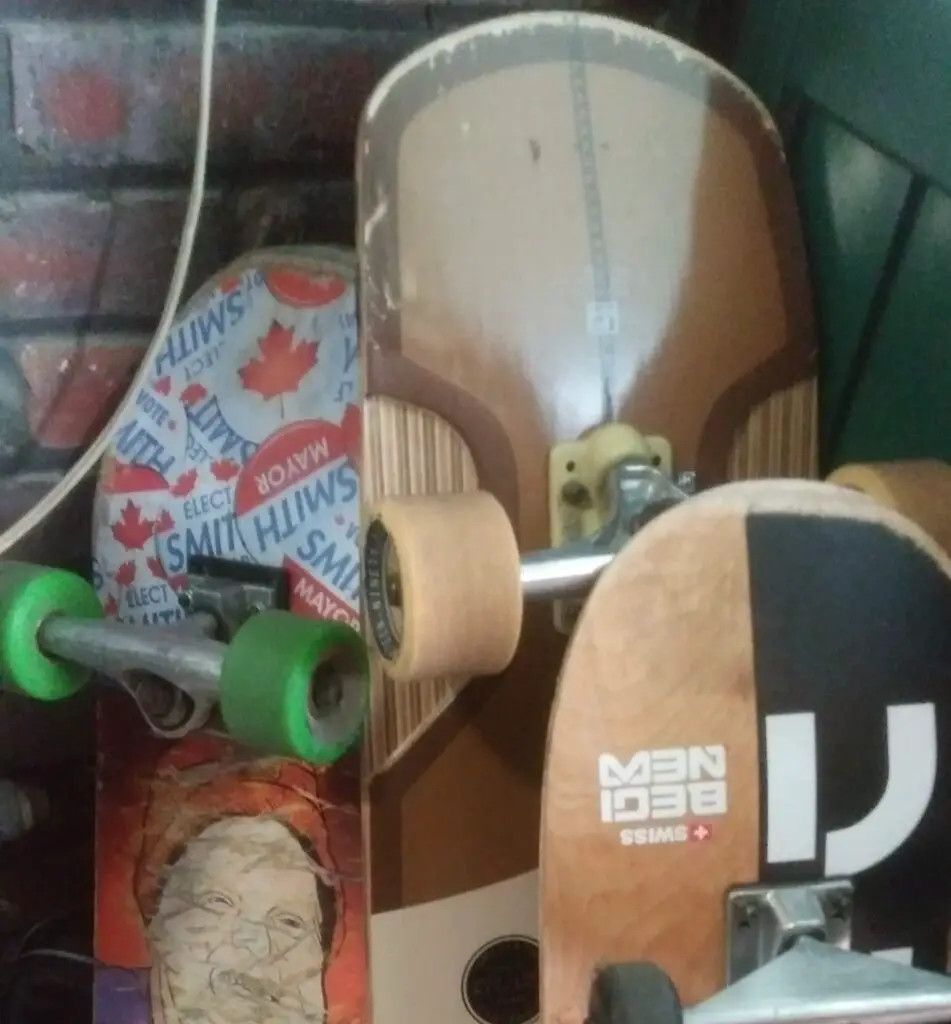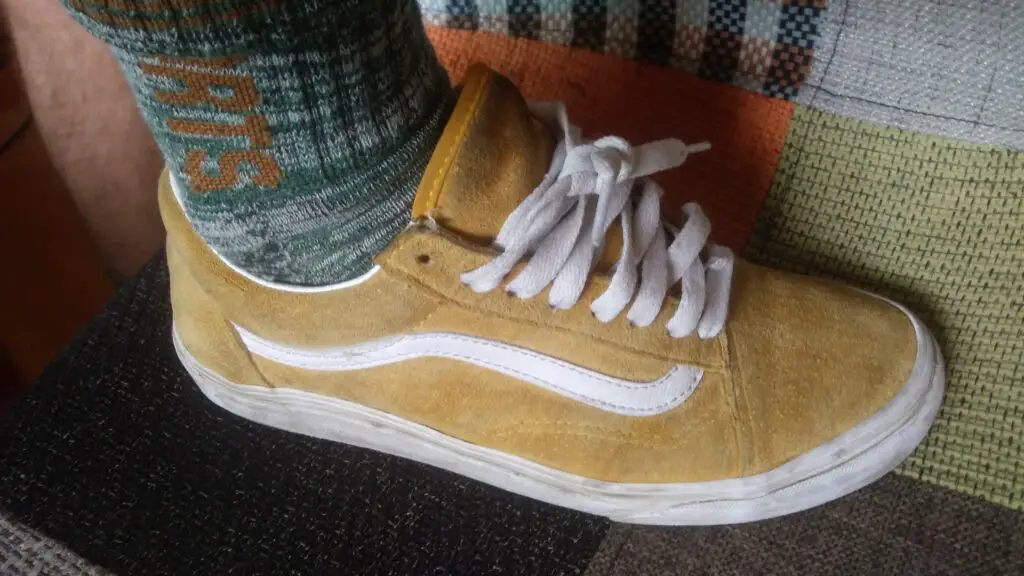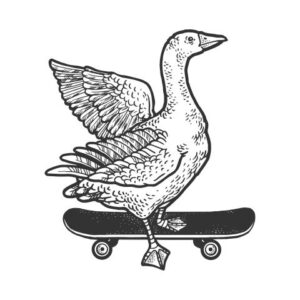Skating in cold weather is something all skaters have to do if they don’t have a local indoor skatepark. Otherwise, there’s just no skating during the winter.
So what’s the best way to deal with the cold? What should you wear for a winter skate session?
Let’s get into it.
How Cold is Too Cold to Skateboard?
This is a difficult question to answer. Personally, anything below 30 °F becomes too cold and uncomfortable no matter how I dress or prepare. Even then, skating at temperatures between 30 °F – 40 °F is still brutal for me and makes me reconsider skating at all. If you have a higher tolerance to cold then maybe skating at lower temperatures is ok for you.
Generally, skateboarding in temperatures below freezing can be a problem, especially in the early morning as frost can make surfaces slippery and dangerous. Otherwise, skateboarding in the cold is just a matter of dressing warmly and your tolerance to the cold. You will quickly warm up and you begin skating and might even end up removing your jacket.
Most of the time, the temperature doesn’t stop you from skating, but an unwillingness to skate in the cold does. Falls hurt more in the cold, it’s harder to get loose, and it can just be plain uncomfortable outside.
Can a Skateboard Get Cold? Storage Tips
Storing your board properly will keep it safe from the wear and tear of exposure to the elements. Often outside in a shed or in your garage might seem like the ideal place to store your skateboard, but it is not.
Quick changes between hot and cold temperatures and moisture can damage your skateboard. Quick temperature changes put internal stresses on the board and cause microcracks which is the first step to fracture. Moisture soaks into the board and can warp the wood as well as fray the grip tape.
Ideally, you want to store your skateboard somewhere that is relatively temperature-controlled and is dry. This can be a closet, the front room in your home, or
Keeping cold once or twice won’t really damage your deck and mostly these effects only occur if the temperature change occurs quickly. Moisture and water exposure will warp and damage your skateboard much more quickly than temperature changes.

If you’re a solo skater and want to teach yourself how to skate, check out our guide on teaching yourself to skate here.
Where to Skateboard in Cold Weather
Indoor Skateparks
Indoor skateparks are your best option to escape the cold and other nasty weather. These are obviously designed to be skated, usually have a good community of skaters, and just have a better vibe than a lot of street spots.
Most big cities will have at least one indoor skate park, but you might need to drive a bit out of your way to get there. This is just the reality for many skaters during the winter. If an indoor park is an hour or two away, they might drive these once a week to skate during the winter and just wait for spring.
Search Google to find a local skatepark near you and if you have one then sign up. Don’t be shy. Even if you’ve never been to a skatepark before or are a beginner, you will gain so much from skating at a park with more experienced skaters.
View this post on Instagram
Parking Garages
Parking garages are almost identical to parking lots, but there is cover from the rain and wind, and often you can carve down to different levels. A parking garage will typically be almost as cold as the outside weather so don’t expect anything warm here. It will save you from a windchill though and usually is a few degrees warmer than outside in general.
I find that I’m more likely to get kicked out of a parking garage than a parking lot. Also, pop tricks tend to echo inside and make a lot of noise. Parking garages might be a good option to try but just be warned that you might be kicked out.
Really a parking garage is best for rainy weather, not so much just cold weather.

Outside in the Cold
This is the answer that most people don’t want to hear, but it most likely is your best bet. If it isn’t wet or rainy, then you can skate outside in your normal spots.
Yes, your slams will hurt more and it will be less comfortable and harder to get loose. Yet, if you don’t get out there, you might not skate for a solid two or three months during the winter.
Just make sure you dress warm enough to skate in the cold and try and warm up quickly. You will be surprised at how hot you get while skating and will likely end up shedding some layers during your session. Avoid the morning as difficult-to-see frost can make surfaces too slippery to skate.
Otherwise, go for it. Invite another friend who is determined to skate to make the session more fun.
Your Garage
I might get some flak for even writing this, but many people started skating in their garage. Alexis Sablone, for instance, is now an Olympic skateboarder who started by skating in her garage because there was no one to skate with in her small town.
Your garage isn’t perfect by any means, but you can practice flat ground tricks in there. The big pitfall is you don’t have room to actually move around and so you usually practice your tricks while not moving. This doesn’t always translate well to doing the trick while moving. I learned a standing still ollie at first, but had to relearn it while moving.
So, I would use this as a supplement to your normal skating. If you’re bored one night and you don’t want to go somewhere, then practicing your kickflips for an hour in the garage can help you progress. Additionally, garages are great for rainy days.
So yeah, just don’t exclusively skate in your garage. That will hinder your progress and is just kind of weird.
If you want to see what celebrities shred, check out the greatest list of celebrities who skate here.
Tips For Skating in the Cold
Avoid Early Morning Skating
I love skating in the morning during the summer especially. You avoid the heat and often get local spots all to yourself.
Unfortunately, early morning can be a session ender in the winter. Often there is some morning frost during the winter that can even cover concrete sidewalks and roads. The frost can make them too slippery to skate. This is often the case for outdoor ramps and kickers.
Usually, concrete that is in a city or urban setting will be fine. Just be cautious and avoid skating transition early in the morning during winter. Of course, this only applies to skate spots that are outside.
Keep Your Feet Warm
This is important as having a numb foot feels bad and also will make flicking and moving your board quite a bit harder. Try and wear thick socks to make sure you don’t lose feeling in your feet and toes. I’ve also tried to stick hand warmers into my shoes before, but this doesn’t really work well.
If your feet do get very cold, don’t stress if you don’t skate as clean as you usually do. This is expected as you will have less control over your feet. You didn’t just suddenly become a terrible skater, I promise.

Dress Just Warm Enough
You will warm up a lot once you get skating. Even if it is below freezing outside, you’ll probably end up sweating during your session.
That being said, you don’t need to dress like you’re about to move to the Arctic. If you dress in too many layers, then you’ll likely end up taking these layers off later anyway. Also, having too many layers makes you heavier and restricts motion.
The trick is to dress just warm enough that you aren’t freezing out there, but can still move comfortably and won’t be taking off five layers and a scarf later.
Don’t Skate if It’s Snowy
This should be a given, but I’ll say it anyway. You can’t skate if it’s snowy outside. The snow means the ground is wet and slippery. Also, getting your board wet will cause problems and damage your board.
Yes, if you can find a dry spot and the snow is not melting for days on end, then go for it, but generally, visible snow means no skating outside. Find an indoor spot or just stay in and read a book. There’s also snowboarding if you have that option.

If you’re worried about getting your skateboard wet, you should be. Check out our guide on why water damages skateboards with a maintenance guide.
What Clothes Should You Wear to Skate in Cold Weather?
Jackets
Windbreakers
Windbreakers are just lightweight, waterproof, and wind-resistant jackets. They look stylish and usually have a hood to cover your head in the rain. They also usually aren’t very warm which is perfect for the cold, but they block the wind which is a big thing in cities like Chicago for instance.
If you have some serious windchill going on, a nice windbreaker will save you. Even if there isn’t much wind, a windbreaker can act as a nice extra layer or very lightweight jacket standalone.
They typically have a polyester exterior and come in almost any color. Not every skate clothing company makes these, but some notable companies like Creature and Santa Cruz do.
Fleece Jacket
I love fleece jackets. These incredibly soft and lightweight jackets are also surprisingly warm. Fleece jackets don’t restrict movement at all and are best for colder months or winter skating. I usually wear mine even if I’m not skating. Seriously, these jackets are cozy and nice.
These are definitely less common to see offered from skating companies as I guess fewer people skate in the winter months. You can find a fleece jacket with Volcom and HUF. Either way, your jacket doesn’t need to come from a skate company to skate in it.
Sweaters
Sweaters can be dorky, comfy, obnoxious, and everything in-between. Skaters like them and you can get a thin lightweight sweater or a thick heavy sweater.
Personally, I think skating with a sweater is great for chilly days as a sweater isn’t restrictive at all and is super comfy. You also get pretty hot while skating and a sweater usually isn’t too warm so that you need to take it off which is a plus.
Plus I think sweaters just plain look good.
Hoodies
Hoodies come in pullovers and zip-ups. These are iconic skateboarding jackets and are common for casual wear for many non-skaters too. The zip-up jacket is not my personal favorite as I prefer the clean look of the pull-over hoodie.
Almost every skate clothing brand will have hoodies for sale. Skaters like them. They are comfortable, warm, and generally loose-fitting enough to skate in.
Throw one on for your cold-weather session and don’t think about it. You’ll warm up quickly as you’re skating so the hoodie doesn’t need to be the warmest. A lightweight hoodie will often do just fine.
Popular Jackets and Outwear Brands
Hats
You lose a lot of heat from your head and your hands so a beanie or a warm hat is a must on very cold days. Caps and bucket hats really won’t do much to keep you warm and are summer season hats.
Beanies
Beanies are pretty common to see and are comfortable and warm. They are nice to wear on cool fall days and they have a very casual feel to them. These are perfect for a cold-weather session and you already probably own one so you won’t need to buy anything.
Don’t be hesitant to take it off after you warm up. You’ll likely be shedding some of your extra clothes late into your skate session.
Trapper Hat
I had to look up the name of this one, but I have one and love it. It is stupid warm and cozy. I also kind of feel like a mountain man when I wear it.
This type of hat is another good choice to wear during a winter session, but could also reduce your sight in your peripherals. A trapper hat is a bit more heavy-duty than a beanie, but if it’s brutally cold outside then you’ll be happy that you have it.
Misc Clothing
Thick Wool Socks
Keeping your feet warm is a priority so thick and warm socks are really essential here. Wool socks are ideal and they are warm and also still retain heat if they get wet. This means that even if you have sweaty feet, they will still keep you nice and warm.
I personally like thick wool socks with bright colors.
Long Johns
Some people swear by Long Johns, but I’ve never liked them myself. They are warm and do add a layer to everything you’re wearing, but the issue is that you can’t take them off easily. This becomes an issue late in the session when you’re warm and sweating.
If you plan on just cruising or if it is truly brutally cold out, then long johns will be fine to wear. I don’t think there is a skate company that sells long johns.

Padded Shorts
Padded shorts are a bit bulky, but will take out the sting from those rough cold weather slams. I’ve personally never worn or even owned padded shorts, but am including them here just so you know they exist and are an option.
Usually, you might see an older skater in full pads with padded shorts as well, but even that’s kind of rare to see. Regardless, don’t be shy if you think they’ll help you out.
Gloves
You lose a ton of heat from your head and your hands. We already talked about the hats you can wear, but you can and should wear gloves. You don’t need your hands to skate unless you’re doing finger flips, cavemans, or other tricks, so gloves really shouldn’t hinder you at all.
I recommend a pair of gloves that aren’t too thick so you still have good control of your hands and fingers. This could help you when you fall and need to sweep your body to the side with your arms.
If you need some extra motivation to get out there and skate, check out our ultimate skateboarding motivation guide.
Conclusion
So that’s it. Dress warm, try and get loose quickly, and just go for it. Skating in the cold can be brutal, but you will warm up quicker than you think. It’s definitely better than just not skating for the winter.
If you can find an indoor skatepark, then you’re lucky and you should go there. Not everyone has that option and it is by far the best one.
Otherwise, avoid early mornings and remember that snow means the ground is wet and unskateable. Wet ground is very slippery and even if you only skate flat ground it can lead to unnecessary slams and injury.
Anyway, thanks for reading, and look out for more articles from Board and Wheels.












